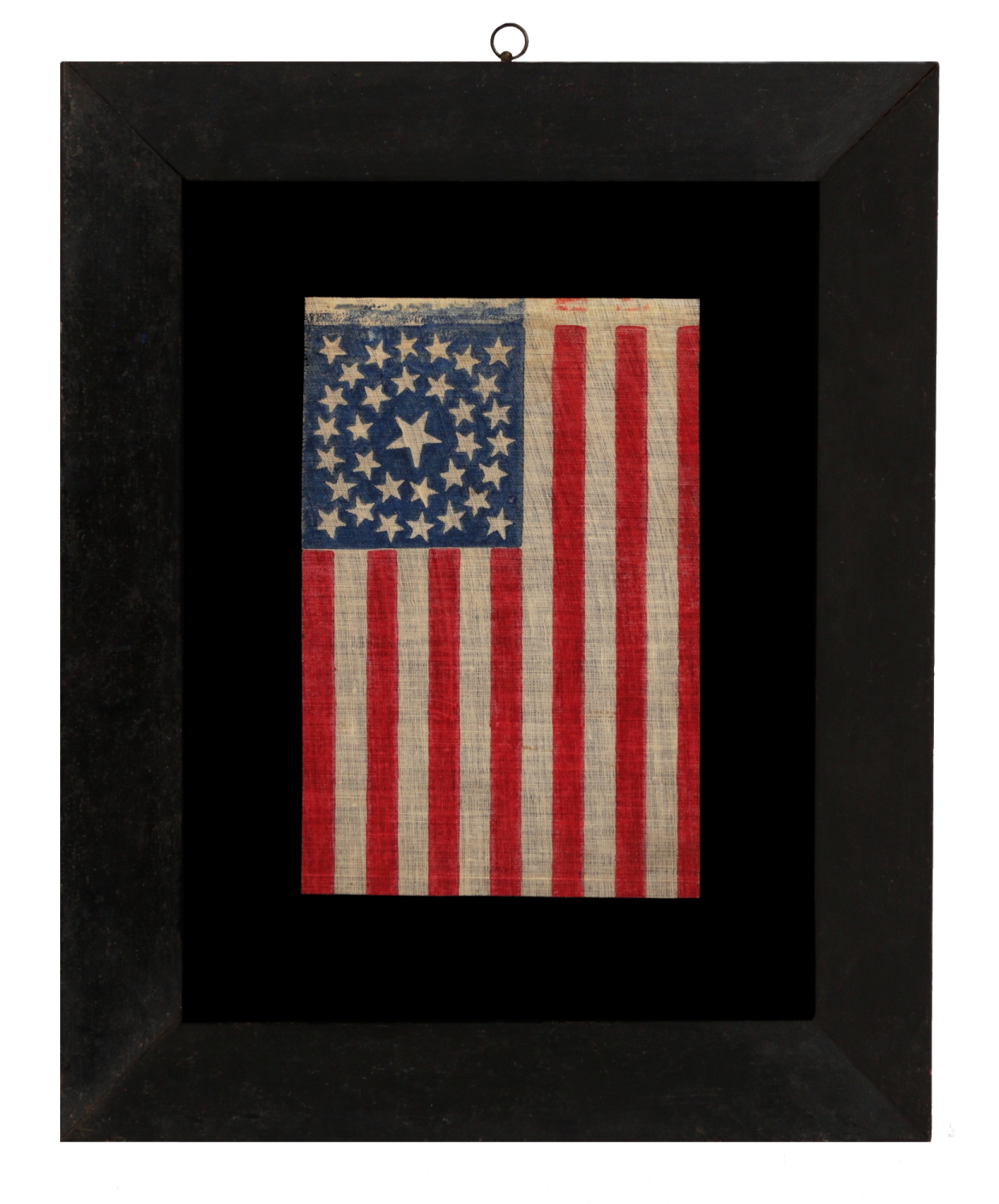


| 33 STARS IN A DOUBLE-WREATH CONFIGURATION, ON AN ANTIQUE AMERICAN FLAG DATING IMMEDIATELY PRE-CIVIL WAR THROUGH THE WAR'S OPENING YEAR, REFLECTS THE ADDITION OF OREGON TO THE UNION, 1859-1861 |
|
| Web ID: | 33j-872 |
| Available: | In Stock |
| Frame Size (H x L): | 15.75" x 12.75" |
| Flag Size (H x L): | 8.75" x 6" |
| Description: | |
| 33 star American national parade flag, block-printed on coarse, glazed cotton. The stars are arranged in a double-wreath style medallion configuration, with a large center star and a flanking star in each corner of the blue canton. Note the crude irregularities present in the shape of the stars, themselves, the profiles of which vary greatly throughout, with arms of various shapes and sizes, oriented this way and that on their vertical axis. The latter is required within the rings, where the arms of the stars intertwine, in order to fit within the confines of the available space. The combination of the above adds a wonderful element of folk quality to the design. This is one of my favorite early parade examples, due to the visual impact of the resulting design. Oregon entered the Union as the 33rd state on February 14th, Valentine’s Day, 1859. The 33 star count became official on July 4th of that year and remained so until July 3rd, 1861, the opening year of the Civil War (1861-1865). This was still the official flag the event that marked the beginning of the war, and aa 33 star flag was flying above it during the attack. Flag makers cared little for what was official. In terms of the sewing or printing of a new flag, as soon as a new state was in, if not even beforehand, in hopeful anticipation, the corresponding star was generally added. Though the 34th star would, theoretically, not be added until July 4th, 1861, because Kansas had already acquired statehood, on January 29th of that year, production for the war, most production went straight to 34 star flags at or around that time. For this reason, 33 star flags were generally not produced for the war, though some, such as the Ft. Sumter flag, remained in service from previous use. For this reason, the 33 can be considered as more of a pre-Civil War flag than a war-period one, which helps to explain why 33 star examples of the American flag are far-and-away more scarce than their 34 and 35 star counterparts. Prior to the Confederate attack on Fort Sumter, the Stars & Stripes was simply not used for most of the same purposes we employ it in today. Private individuals did not typically display the flag in their yards and on their porches. Parade flags didn't often fly from carriages and horses. Places of business did not commonly hang flags in their windows. Private use of the national flag rose swiftly during the patriotism that accompanied the Civil War, expanding from there on. Even the military did not use the flag in a manner that most people might think. The primary purpose before the Civil War was to mark ships on the open seas. While flags were used to mark garrisons and government buildings, those of ground troops were often limited to the flag of their own regiment, with a design peculiar unto itself, plus flank markers bearing the unit’s numeric / alphabetic designations (usually on a buff yellow or blue ground), and perhaps a federal standard (also blue or buff yellow) bearing the arms of the United States. Most people are surprised to learn that ground forces were not authorized to carry the Stars & Stripes until it was assigned to artillery regiments in 1834. Infantry was afforded the privilege in 1841, just prior to the Mexican War (1846-1848), while cavalry regiments were not issued their iconic, swallowtail, Stars & Stripes format guidons until the second year of the Civil War, in 1862. The first war in which the Stars & Stripes was officially carried was thus the Mexican War (1846-48); surviving battle flags of that time frame are extraordinarily rare. Mounting: The flag was mounted and framed within our own conservation department, which is led by expert staff. We take great care in the mounting and preservation of flags and have framed thousands of examples. The mount was placed in a black-painted molding, with a beveled profile and exceptional, early surface, that dates to the period between roughly 1840 and 1860. The background is 100% cotton twill, black in color, that was washed and treated for colorfastness. Spacers keep the textile away from the glazing, which is U.V. protective glass. Condition: This is an excellent example among its counterparts. There is some misprinting of the blue and red pigments into the hoist area, and extremely minor misprinting within the canton. There is extremely minor fraying along the top edge of the flag, near the hoist, and there is extremely minor soiling in limited areas. |
|
| Video: | |
| Collector Level: | Intermediate-Level Collectors and Special Gifts |
| Flag Type: | Parade flag |
| Star Count: | 33 |
| Earliest Date of Origin: | 1859 |
| Latest Date of Origin: | 1861 |
| State/Affiliation: | Oregon |
| War Association: | 1777-1860 Pre-Civil War |
| Price: | Please call (717) 676-0545 or (717) 502-1281 |
| E-mail: | info@jeffbridgman.com |
 |
|